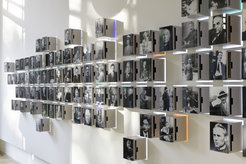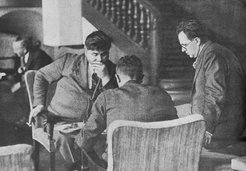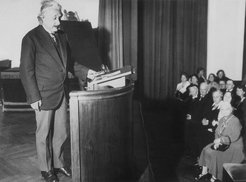Portrait wall
Guests from 1929-1953

From 1929 to 1943, Harnack House operated as a hotel for international scientists as well as diplomatic guests of the Foreign Ministry. Some researchers stayed for several months during their time as research fellows. At that time, the House was managed by the Kaiser Wilhelm Society (KWG). Following its foundation in 1911 as the first institution in Germany dedicated to basic research, the KWG had quickly made a name for itself as a leading institution for cutting-edge research. The KWG invitation policy was wholly in keeping with this position. At present, we know of at least 35 Nobel Prize winners across all disciplines who spent time at Harnack House between 1929 and 1943. Some hosted events here, such as Max Planck, Fritz Haber and Otto Hahn; others, including Indian poet Rabindranath Tagore and Hungarian biochemist Albert von Szent-Györgyi, came as guests.

However, the House was also visited by politicians, including Gustav Stresemann and Marie-Elisabeth Lüders, as well as figures from the arts such as Henny Porten and Gustaf Gründgens. Industrialists were particularly important for the Kaiser Wilhelm Society, and visitors from this field included Carl Friedrich von Siemens and Gustav Krupp von Bohlen und Halbach. The lists of guests and events reflect the Kaiser Wilhelm Society’s wide-reaching networks, which it maintained and expanded at Harnack House.
The historical figures are roughly arranged in chronological order of their association with the building, starting with its eponymous founder, Adolf von Harnack. The installation invites guests to explore the building’s history along 30 topical paths. Together, they provide a picture of life at Harnack House as a piece of contemporary German history. With that in mind, the installation consciously includes figures who played prominent roles in the National Socialist era. These include architect and Minister of Armaments Albert Speer and eugenicist Eugen Fischer.
Each individual on the portrait wall is part of a topical path comprising three to eight biographies. When a box on the wall is opened, lights in the same color reveal the rest of the topical path. The portrait boxes provide a short biography of the individual. Visitors can also take a card from the slot in each box to find out more about these figures and the connections between them. Nobel Prize laureates have the honor of full-format portrait cards.
Nobel Prize laureates

Between 1929 and 1943, Harnack House is known to have hosted a total of 35 Nobel Prize laureates, ten of whom were international guests. Even prior to the House’s construction, the Kaiser Wilhelm Society (KWG) had appointed a body, primarily composed of the Directors of Kaiser Wilhelm Institutes in Dahlem, which put forward proposals for international scientists who should be invited to Berlin as fellows or guest speakers. The biochemist Carl Neuberg and biologist Richard Goldschmidt were particularly active in maintaining these relationships, as was Michael Polanyi, Head of Department at the Fritz Haber Institute.
Many of the guests were already Nobel Prize laureates at the time of their invitation, though others went on to receive the prize at a later date. Hans Fischer received news of his 1930 Nobel Prize while visiting Harnack House.
Among the researchers already honored with the Nobel Prize before their visit were biochemists Otto Fritz Meyerhof and Otto Warburg, physicists Max Planck, Max von Laue and Albert Einstein, plus Fritz Haber – all of whom became Scientific Members of the Kaiser Wilhelm Society. In 1932, Harnack House hosted Hans Krebs, a junior scientist who would only receive the Nobel Prize much later in life but whose career began in the KWG in Dahlem. Konrad Lorenz, who gave a lecture at Harnack House in 1936, was another who was awarded the Nobel Prize long after his visit, by which time he was a Member of the Max Planck Society.
Adolf Butenandt and Richard Kuhn were regular guests at Harnack House during the Third Reich. Their nominations for the Nobel Prize, in 1939 and 1938 respectively, represent exceptional cases for science during the National Socialist era. Because the two researchers were unable to accept the Nobel Prizes awarded to them as Hitler had issues a ban on doing so. This prohibition was in response to the decision to honor pacifist and publicist Carl von Ossietzky with the Nobel Peace Prize for 1935. Ossietzky was arrested in 1933 due to his opposition to the Nazi regime and imprisoned in a concentration camp. A friend of Ossietzky started a campaign and put his name forward for the Nobel Peace Prize in order to raise public awareness of his case. When this campaign proved successful, Hitler issued a ban on all Germans accepting the Nobel Prize. Butenandt and Kuhn accepted the honors after the Second World War, at a time when they had become Members of the Max Planck Society.


